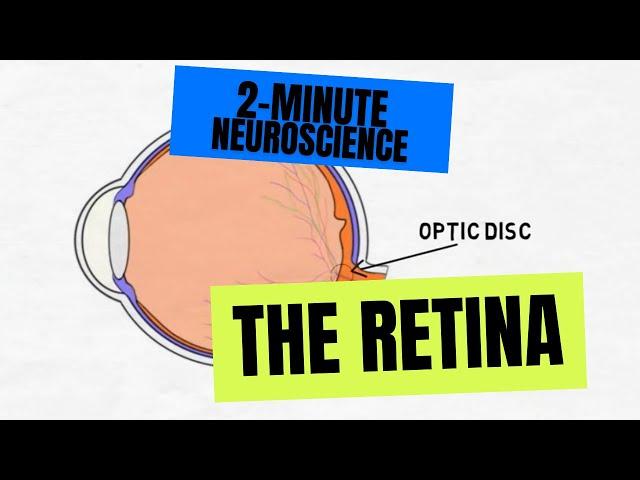
2-Minute Neuroscience: The Retina
**CORRECTION** The image of the cell layers of the retina at 0:12-0:15 is reversed. The photoreceptors should be at the very back of the retina; light must travel through the other cell layers of the retina before reaching the photoreceptors. Note that the images throughout the rest of the video (after 0:15) are correct. Follow this link to see a corrected image: https://www.neuroscientificallychallenged.com/retina-correction
For an article (on my website) that explains the retina, click this link: https://neuroscientificallychallenged.com/posts/know-your-brain-retina
TRANSCRIPT:
Welcome to 2 minute neuroscience, where I simplistically explain neuroscience topics in 2 minutes or less. In this installment I will discuss the retina.
The retina contains the neural component of the eye. When light reaches the back of the eye, it enters the cellular layers of the retina.
The cells of the retina that detect and respond to light, known as photoreceptors, are located at the very back of the retina. There are two types of photoreceptors: rods and cones. Rods allow us to see in dim light, but don't allow for the perception of color. Cones, on the other hand, allow us to perceive color under normal lighting conditions. Throughout most of the retina, rods outnumber cones. In one area called the fovea, however, there are no rods but many cones. The fovea represents the area of the retina that provides our highest acuity vision, and thus is at the center of our gaze.
When light hits photoreceptors, it interacts with a molecule called photopigment, which begins a chain of events that serves to propagate the visual signal. The signal is transmitted to cells called bipolar cells, which connect photoreceptors to ganglion cells. Bipolar cells pass the signal on to ganglion cells, which leave eye in a large cluster at an area called the optic disc. The optic disc doesn't contain any photoreceptors, and so represents an area on the retina that can't process visual information, creating a natural blind spot. However, we normally don't notice our blind spot. The brain uses information from surrounding photoreceptors and the other eye to fill in the gaps in images that are processed by the retina. After leaving the retina, the ganglion cell fibers are called the optic nerve. The optic nerve carries visual information toward the brain to be processed.
There are two other cell types in the retina that should be mentioned: horizontal and amacrine cells. Horizontal cells receive input from multiple photoreceptor cells. They integrate signaling from different populations of photoreceptor cells, make adjustments to the signals that will be sent to bipolar cells, and regulate activity in photoreceptor cells themselves. Amacrine cells receive signals from bipolar cells and are involved in the regulation and integration of activity in bipolar and ganglion cells.
REFERENCE:
Nolte J. The Human Brain: An Introduction to its Functional Anatomy. 6th ed. Philadelphia, PA. Elsevier; 2009.
Тэги:
#Neuroscience_(Field_Of_Study) #Brain_(Anatomical_Structure) #Optic_Nerve_(Cranial_Nerve) #Retina_(Anatomical_Structure) #PhotoreceptorsКомментарии:

Hello Aviators 😂
Ответить
Thank you so much sir ❤❤
Ответить
Perfect
Ответить
Marvelous
Ответить
Not enough info.
Like what are the types of horizontal cells, what are their inputs, do they have dendrites, axons, are they interconnected between each other?

yea but how does photoreception work. How do the rods and cones turn light into nerve signal? Why are they shaped differently? Why does the shape matter? What are they made out of? are the rod and cone portion of the cell made of a special material?
Ответить
Your videos r really helpful for the last minute... Idk y it is so underated
Ответить
I had a left side stroke. Never going to be able to drive a car or do anything like that again. My left eye has black splotches that covers whatever i look at if i have my right eye closed. with both eyes open everything is just out of focus for me unless i am able to look at it for a period of time without movement. I am still trying to find more about this.
Ответить
I'm a bit confused - so light hits ganglion cells, message passes to bipolar then rods/cones, then BACK to ganglion cells to pass along nerve to optic disc?
Ответить
top tier channel
Ответить
My retina is damage I can't see an object , Na 😭
Ответить
Where are the visual receptors (pink cones)?
A. The layer that is bloody
B. cornea
C. retina
D. Lens

Merci <3
Ответить
Thank you so much ✨🙏❤️
Ответить
Thank you so much
Ответить
Sooo my question at this point: If Glutamat normally is excitatory why does it work as inhibitor on bipolar cells? And aditionally, why is GABA on biopolar cells an excitator but works normally as inhibitory neuro transmitter? I totally don't understand it every time, I watch something about the function of eyes.
Ответить
I love you
thank you so much

Ingest oils to enhance contrast in vison.
Ответить
Can you make video on cataract and eye donation
Ответить
So does light travel through the retinal ganglion cells and bipolar cells to get to the photoreceptors and then get processed starting from photoreceptors going down or does light just have to pass the other cells to get to the photoreceptors?
Ответить
Thank you for the good explanation.
Ответить
one word....phenomenal...
Ответить
Thank you
Ответить
man can you talk any faster than this :) ?????
Ответить
Could someone explain in a little more detail what horizontal and amacrine cells do?
Thanks!

hey which aap u use for editing? its awesome ..
Ответить
Rods and cones are electrically active or inactive?
Ответить
Yo does anyone know what kind of level in science this is pls??
Ответить
THANK YOU!!
Ответить
Thank you!
It’s a great video.

"no rods" in the fovea. Oh... so that's why, when it's dark, you can see things in your peripheral, but not when looking straight at them.
Ответить
Could you please speak a bit clearer?
Ответить
Studying for my perception test in 4 hours and this helped. My professor is great but the diagram he gave made it confusing to how the radiation got to the back of the eye.
Ответить
What would happen if you could direct an electric charge back along the optic nerve to the photoreceptors? Would they emit light?
Ответить
Thank you very much.
Ответить
Yes Virginia...God is Awesome!
Ответить
sorry ..its cones not comes...
Ответить
please cones have especially one by one connection with bipolar cells...
and its your pictuers its form allot connection with bipolar cells..
For confirmation you see the DR NAJEEB vedio

Based on what I have heard about the Retina, the amacrine cells receive information before the horizontal cells. Can you try to look that up?
I think you have switched those two by mistake :)

Nice
Ответить
really good video!
Ответить
Thank you!
Ответить
This helped me alot to understand the eye better👍
Ответить

![[MMD RWBY] Body shaming [MMD RWBY] Body shaming](https://ruvideo.cc/img/upload/c1EtZGpaNEFMRm0.jpg)























